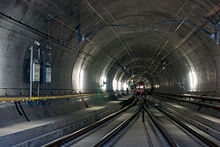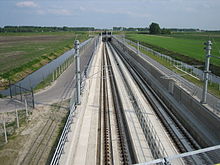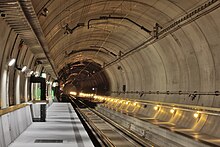Ballastless track

Aballastless trackorslab trackis a type ofrailway trackinfrastructure in which the traditional elastic combination ofsleepersandballastis replaced by a rigid construction ofconcreteorasphalt.

Characteristics
[edit]In ballastless tracks, therailsare either discretely supported or continuously supported. Discretely supported rails sit on elastomeric pads and are rigidly fastened to special types of concrete sleepers. These sleepers are themselves set set directly in concrete or in rubber 'boots' and both are then set in concrete. Continuously supported rails are generally fixed in slots in the concrete slab and called Embedded Rail Track. The rails, which can be either traditional Vignole Rails with a head, web and foot, or block rails with no web, are either cast into the slots by an elastic compound or surrounded by an close-fitting boot before being fixed in place with grout. Both the surface mounted rail and the embedded block rail can be simply removed and replaced.
Ballastless tracks offer a high consistency intrack geometrywhich is difficult to adjust after the concreting of the superstructure; they must therefore be concreted with a tolerance of ± 1.0 mm.[1]
The elasticity of the ballast in the traditional railway superstructure is replaced by flexibility between either the discretely supported rails and the concrete sleepers, or the sleepers and the concrete or asphalt slab (e.g., with sleeper boots). The slab itself is relatively inelastic.[1]
Advantages
[edit]The advantages of a ballastless track over a traditional superstructure are its highly consistent track geometry, its longer life span, and the reduced need formaintenance.[2]
A ballastless track's track geometry is achieved mainly due to its relative inelasticity in comparison to a traditional superstructure. This results in far fewer deformations and generally smoother running;train drivers (engineers)of theLondon Overground'sEast London Linehave informally declared the Low Vibration Track system as the smoothest superstructure they have experienced.[3]Measurements conducted in Switzerland in 2003 and 2004 showed a standard deviation of the gauge of less than 1.2 millimetres (0.047 in).[2]This in turn increases the track's life span and reduces the need for maintenance. The usual preventive maintenance is limited to rail grinding and, in the case of surface mounted rail, inspection of the rail fi xing s, sincetampingis not necessary due to the absence of ballast. Curative maintenance beyond rail and fi xing replacement is required only after several decades. TheSwiss Federal Railwaysreplaced the sleepers and rubber shoes of the ballastless track in the 4.9-kilometre (3.0 mi)-longHeitersberg Tunnelbetween 2014 and 2016, whereas no maintenance of the concrete slab was necessary 39 years after the tunnel's opening.[4][5]
Due to its good experiences with the system, the Swiss Federal Railways are looking to install ballastless track wherever there is a rigid substructure—in tunnels as well as onviaducts.[5]Elsewhere ballastless track is used in the open.
Further advantages of ballastless tracks include better and controlleddrainage,the elimination of flying-ballast damage onrolling stockandcivil engineeringstructures, a shallower superstructure, and the possibility of run-over sections such ascrossingsover whichpneumatic vehiclescan be driven. When used in stations, ballastless tracks are easier to clean.[5]
Embedded track has the potential for increased safety through simple derailment protection and support of broken rails. They alone can also be installed by the efficient placing of the slab using the slipform process. All these benefits lead to increased track access for the traffic.
Disadvantages
[edit]The primary disadvantage of a ballastless track is its sometimes significantly higher cost of initial construction. While numbers vary depending on construction type and track infrastructure (ballastless tracks are generally more suitable to infrastructures that are also made of concrete, as is the case in tunnels or on viaducts), theDeutsche Bahnestimated in 2015 that construction costs of ballastless tracks are in many cases 28 percent higher than those of traditional superstructure.[6]]However, thelife-cycle costof ballastless tracks are generally lower than those of ballasted tracks due to significantly lower maintenance.[7]
Further disadvantages of ballastless tracks are the difficulty of adjusting or correcting track geometry once concrete has been set, the necessity of a stable infrastructure (since adjustments to the superstructure can be onerous), generally higher noise emissions, and longer repair times when the concrete slab is damaged (for e.g., due to construction faults, wear and tear, or accidents). Inflexibility of the track and the need to be careful with transitions between ballasted and ballastless tracks have been cited as well.[8]
Construction types
[edit]Early slab track projects a range of construction types, sub-bases and fastening technologies.[9]The following list contains construction types of ballastless tracks that have been internationally used in heavy-rail systems (as opposed tolight railways,tramways,ormetros) in chronological order of their first usage.[8][10]
SBB Bözberg/STEDEF (SBB)
[edit]The Bözberg/STEDEF system consists of twin sleepers that are connected by a steel track rod and enclosed in a rubber shoe. All of its components can be exchanged individually. Bözberg/STEDEF was first used by the Swiss Federal Railways in theBözberg tunnelin 1966.[5]STEDEF was further developed by SATEBA prior to the system's installation on the FrenchLGV Méditeranée.[11]

Rheda (Rail.One)
[edit]The Rheda system consists of three layers: a base course and two slabs that are joined byrebars,as are the individual sleepers. Rheda was first used by the Deutsche Bahn inRheda-Wiedenbrück station,after which it is named, in 1972. It has since been installed on the DutchHSL-Zuid routebetweenAmsterdamandRotterdam,in the SpanishGuadarramaandSant Joan Despítunnels, and on various Chinese high-speed lines includingWuhan–Guangzhou High-Speed Railway.[12]
Bögl (Max Bögl)
[edit]The Bögl ballastless track is characterised by its use ofprefabricatedconcrete slabs in lieu of a continuous structure that is cast on site.Mortaris used to connect the 9-ton slabs to the infrastructure and to one another. The Bögl system was developed in Germany and first tested inDachauin 1977. The first serial installation took place inSchleswig-HolsteinandHeidelbergin 1999. For its use on thehigh-speed link between Beijing and Shanghai,406,000 slabs were installed.[13]
FF ÖBB/PORR (PORR)
[edit]The ÖBB/PORRballastless track (FF stands for GermanFeste Fahrbahn,meaningballastlessor, literally,fixed track) consists of an elastically supported track slab. It was first tested in 1989, became the standard system in Austria in 1995,[14]and has been used for over 700 kilometres of track worldwide, including the German Verkehrsprojekt Deutsche Einheit Nr. 8 (German Unity Transport Project 8) and theDoha metro.The system will be used on the first phases of the United Kingdom'sHigh Speed 2line, except in tunnels and for some specialist structures.[15]It is also being used for theDelhi-Meerut RRTS,the first of 3RRTSsystems currently being implemented inDelhi-NCRbyNCRTC.[16]

Low Vibration Track (Sonneville/Vigier Rail)
[edit]The Low Vibration Track (LVT) system is similar to Bözberg/STEDEF in that it also uses twin sleepers enclosed in rubber shoes.[5][17]However, LVT does not feature a tie rod.[5]The system was developed and tested by Roger Sonneville together with the Swiss Federal Railways in the 1990s[1]before the rights were sold to Vigier Rail in 2009.[18]LVT has been in service in theChannel tunnelsince 1994. Due to the tunnel's German nameEurotunnel,LVT is sometimes referred to as Euroblock. LVT has been used for over 1300 kilometres of track worldwide, including the SwissLötschberg,GotthardandCeneribase tunnels, the South Koreanhigh-speed Suin Line between Songdo and Incheon,the TurkishMarmaray project,and theLondon Overground'sEast London line,as well as on viaducts in urban areas.[19][20]LVT has become the standard ballastless-track system in Switzerland.[21]
Embedded Rail Track (ERT)
[edit]The Embedded Rail Track system uses a removable block rail and boot pad that requires no fi xing s but meets all the performance requirements of heavy freight (40T axles), high speed, light rail and mainline traffic loads. The system has been approved for use in Germany and the UK and tested on the Spanish high speed and heavy freight test track at Medina del Campo in Spain. Installed in 2003 as part of the UK West Coast main line at Crewe - Kidsgrove it has had zero maintenance since then while still retaining its as built track alignment. The slab can uniquely be installed as pre-cast, insitu or slipformed concrete. It provides close derailment protection and allows traffic to pass over a broken rail, Due to the additional available head wear it has twice the rail life and with only three components per track metre delivers excellent track availability at an installed cost approaching that of ballasted track. Unlike other slab tracks with surface mounted rails the concreting,alignment and railing installation activities have been decoupled to eliminate the programme and installation risks.
IVES
[edit]The IVES system (Intelligent,Versatile,Efficient andSolid) is a product of Rhomberg Rail. The system consists of a base layer (preferably common asphalt concrete) and concrete lateral structural elements, in which the rail fastening elements of the type DFF 304[22]are directly embedded – no sleepers are needed. The necessary elasticity is given only by a flexible intermediate plate in the rail fastening elements.
The structural elements of this system are individually manufactured and can be positioned laterally or longitudinally onto the base layer. The structural elements have recesses in the top, where the rail fastening elements are placed into. Afterwards, the rails are lifted onto the fastening elements and a track grid is established. The grid's exact position can now be adjusted vertically and laterally. At last, the rail fastening elements are friction-locked to the structural elements with high-strength grouting mortar. Thanks to its versatile construction and easy installation, IVES is suitable for all rail types.[23]
After testing, the first IVES track has been installed in the Asfordby Tunnel of theOld Dalby Test Trackin England in 2013[24]and since then, seven more IVES tracks have been built. The longest IVES track runs through the Bruggwaldtunnel in Switzerland, with a total length of 1,731 m (5,679 ft).[25]
See also
[edit]Baulk trackand slab track are similar in that the rails are continuously supported, compared to ordinary track where the rails have to "bridge" the gaps between the sleepers.[citation needed]
References
[edit]- ^abc"Precision laying of low-maintenance track".Railway Gazette International:44f. July 2011.
- ^abRutishauser, Gérard (2005).Slab Track "Swiss Made": 40 Years Successful Experience.European Slab Track Symposium 2005. pp. 3, 10.
- ^Whitelaw, Jackie (27 May 2010). "East London Line: Southern Section".New Civil Engineer:38.
- ^"S-Bahn- und Fernverkehr Zürich–Olten: SBB saniert Fahrbahn im Heitersbergtunnel | SBB".sbb.ch(in German). 18 December 2013. Archived fromthe originalon 1 October 2017.Retrieved17 September2017.
- ^abcdef"Gotthard Base Tunnel completes LVT installation".Railway Gazette International:40f., 43. January 2015.
- ^Zippel, Tino (17 June 2015)."Pünktlicher Start für ICE-Neubaustrecke: Deutsche Bahn arbeitet an Plan B".Ostthüringer Zeitung(in German). Archived fromthe originalon 17 December 2015.Retrieved17 September2017.
- ^Awasthi, Anupam (28 November 2020)."Slab Track System for High Speed Railway".nhsrcl.in.NHSRCL.Retrieved3 January2023.
From Japanese experience, it has been learnt that although initial construction cost of slab track is about 1.3 times higher compared to conventional ballasted track, if we consider life cycle cost in the long run, slab track seems to win the race.
- ^abEsveld, Coenraad (2001).Modern Railway Track(PDF).The Netherlands: MRT-Productions. p. 233.ISBN90-800324-3-3.
- ^"Technical and Economic Feasibility Study of At-Grade Concrete Slab Track for Urban Transit Systems"(PDF).1981.Retrieved16 November2019.
- ^Michas, Georgios (2012).Slab Track Systems for High-Speed Railways (Master Degree Project)(PDF)(Technical report). Royal Institute of Technology, Stockholm, Sweden. TSC-MT 12-005.
- ^"Système de voie sans ballast".Consolis SATEBA(in French). 2012.Retrieved17 September2017.
- ^"Feste Fahrbahn Rheda 2000"(PDF).Rail.One(in German). April 2011. pp. 2f.Retrieved17 September2017.
- ^Firmengruppe Max Bögl: "Hochgeschwindigkeit in China mit FF Bögl"MB Quadrat (in German). 2010. pp. 18f.
- ^"Slab Track Austria: System ÖBB-PORR elastically supported slab (sic)"(PDF).Slab Track Austria.2012. p. 2.
- ^"HS2 slab track contract awarded".Railway Gazette International.5 October 2020. Archived fromthe originalon 7 October 2020.Retrieved7 October2020.
- ^"In-principle approval of broad technologies for regional rapid transit system (RRTS)"(PDF).indianrailways.gov.in.Ministry of Railways. 18 November 2020. p. 1.Retrieved3 January2024.
NCRTC has selected "Austrian Slab Track System" for track on main line.
- ^Carr, Collin (May 2014). "Canal Tunnels: Exercising Foresight".The Rail Engineer:30.
- ^Sonneville AG (2017)."History".sonneville.Retrieved23 September2017.
- ^Sonneville AG (July 2015)."LVT Reference List - Metric Version"(PDF).sonneville.Retrieved23 September2017.
- ^Sonneville AG (2017)."LVT on Viaducts".sonneville.Retrieved23 September2017.
- ^Rubi, Thomas; Gerber, Tobias; Trovato, Marco; Hengelmann, Anabel; Laborenz, Peter; Ziegler, Armin (August 2012). "Keeping it Quiet Below the Streets of Zürich".Railway Gazette International:44–7.
- ^AG, Vossloh."System DFF 304".vossloh(in German). Archived fromthe originalon 30 April 2019.Retrieved7 June2019.
- ^Rhomberg Rail."Documentation Slab Track IVES"(PDF).Retrieved1 June2019.
- ^Rhomberg Rail."References IVES"(PDF).Retrieved7 June2019.
- ^"Von der Tradition zur Moderne".Schriftzug(in Swiss High German). 26 February 2019.Retrieved7 June2019.
